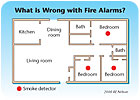ANSWERS BELOW.
- NFPA 72 is the National Fire Alarm Code.
- True
- False
- What is the maximum number of water flow switches permitted to be connected to a single initiating device circuit?
- 1
- 2
- 3
- 4
- 5
- What is the maximum number of supervisory devices permitted to be connected to a single initiating device circuit?
- 10
- 20
- 30
- 40
- 50
- In new one and two family dwellings, which of the following are the requirements for smoke detector installation?
- In all sleeping rooms
- Outside of each separate sleeping area
- On each level of the dwelling
- All of the above
- None of the above
- When installing initiating devices, they shall be supported independently of their attach-ment to the circuit conductors.
- True
- False
- A ceiling is considered smooth if it is uninterrupted by continuous projections, such as solid joists, beams or ducts, extending more than how many inches below the ceiling surface?
- 2
- 4
- 6
- 8
- 12
- When reading the Fire Alarm Code, the word “shall†indicates a recommendation but is not required.
- True
- False
- When reading the Fire Alarm Code, the word “should†indicates a mandatory requirement.
- True
- False
- Which of the following is an example of a smoke detector?
- Cloud chamber
- Ionization
- Photoelectric
- Any of the above
- None of the above
- For complete detector coverage, detectors must always be installed in concealed accessible spaces above suspended ceilings that are used as a return air plenum.
- True
- False
- When the height of a ceiling is 15 feet, which of the following spacing reduction factors must be used to properly locate heat detectors?
- 0.91
- 0.84
- 0.77
- 0.71
- When mounting smoke detectors on a wall, they should be installed between 4 and 12 inches down from the ceiling to the top of the detector.
- True
- False
- Ionization system smoke detectors must be functionally tested annually.
- True
- False
- Fixed-temperature heat-sensing devices are marked with a color code indicating their temperature classification.
- True
- False
- What is the minimum mounting height above the finished floor (AFF) for a wall-mounted audible notification device?
- 72 inches to top of device
- 72 inches to bottom of device
- 90 inches to top of device
- 90 inches to bottom of device

What’s Wrong with This?
Wally ‘Larman installed a fire alarm system for a new single dwelling home without any basement, installing a smoke detector in each bedroom as shown in this diagram, along with an approved control, command center and notification appliances. He used only listed equipment and wired each device according to the manufacturer’s instructions. When the installation was completed, Wally tested it to make sure everything functioned as designed, but when the inspector arrived, he was not satisfied. Can you see what Wally did wrong and what he must do to correct the problem?5-Minute Tech Quiz Answers
Here are the answers to the 5-Minute Tech Quiz and What’s Wrong with This? that appears on page 53.- a
- e — NFPA 72 6.8.5.5.2 states, “The number of water flow switches permitted to be connected to a single initiating device circuit shall not exceed five.â€
- b — NFPA 72 6.8.5.7.2 states, “The number of supervisory devices permitted to be connected to a single initiating device circuit shall not exceed 20.â€
- d
- a — NFPA 72 5.4.3 states, “Initiating devices shall be supported independently of their attachment to the circuit conductors.â€
- b
- b — “Shall†indicates a mandatory requirement; “Should†indicates a recommendation.
- b
- d
- b — NFPA 72 5.5.2.1.5 states, “Detectors shall not be required in concealed, accessible spaces above suspended ceilings that are used as a return air plenum meeting the requirements of NFPA 90A, Standard for the Installation of Air Conditioning and Ventilating Systems, where equipped with smoke detection at each connection from the plenum to the central air-handling system.â€
- c
- a — NFPA 72 5.7.3.2.1 states, “Spot-type smoke detectors shall be located on the ceiling not less than 100mm (4 in.) from a sidewall to the near edge or, if on a sidewall, between 100mm and 300mm (4 in. and 12 in.) down from the ceiling to the top of the detector.â€
- a



